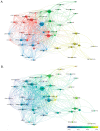microRNAs: Key Players in Plant Response to Metal Toxicity
- PMID: 35955772
- PMCID: PMC9369385
- DOI: 10.3390/ijms23158642
microRNAs: Key Players in Plant Response to Metal Toxicity
Abstract
Environmental metal pollution is a common problem threatening sustainable and safe crop production. Heavy metals (HMs) cause toxicity by targeting key molecules and life processes in plant cells. Plants counteract excess metals in the environment by enhancing defense responses, such as metal chelation, isolation to vacuoles, regulating metal intake through transporters, and strengthening antioxidant mechanisms. In recent years, microRNAs (miRNAs), as a small non-coding RNA, have become the central regulator of a variety of abiotic stresses, including HMs. With the introduction of the latest technologies such as next-generation sequencing (NGS), more and more miRNAs have been widely recognized in several plants due to their diverse roles. Metal-regulated miRNAs and their target genes are part of a complex regulatory network. Known miRNAs coordinate plant responses to metal stress through antioxidant functions, root growth, hormone signals, transcription factors (TF), and metal transporters. This article reviews the research progress of miRNAs in the stress response of plants to the accumulation of HMs, such as Cu, Cd, Hg, Cr, and Al, and the toxicity of heavy metal ions.
Keywords: heavy metals; miRNA; response; toxicity response; transcription factor.
Conflict of interest statement
The authors have no conflict of interest to declare.
Figures



Similar articles
-
miRNA-based heavy metal homeostasis and plant growth.Environ Sci Pollut Res Int. 2017 Apr;24(11):10068-10082. doi: 10.1007/s11356-017-8593-5. Epub 2017 Feb 22. Environ Sci Pollut Res Int. 2017. PMID: 28229383 Review.
-
MicroRNA mediated regulation of metal toxicity in plants: present status and future perspectives.Plant Mol Biol. 2014 Jan;84(1-2):1-18. doi: 10.1007/s11103-013-0120-6. Epub 2013 Aug 23. Plant Mol Biol. 2014. PMID: 23975146 Review.
-
MicroRNAs: Tiny, powerful players of metal stress responses in plants.Plant Physiol Biochem. 2021 Sep;166:928-938. doi: 10.1016/j.plaphy.2021.07.004. Epub 2021 Jul 5. Plant Physiol Biochem. 2021. PMID: 34246107 Review.
-
A potential role of microRNAs in plant response to metal toxicity.Metallomics. 2013 Sep;5(9):1184-90. doi: 10.1039/c3mt00022b. Metallomics. 2013. PMID: 23579282 Review.
-
Heavy-metal-induced reactive oxygen species: phytotoxicity and physicochemical changes in plants.Rev Environ Contam Toxicol. 2014;232:1-44. doi: 10.1007/978-3-319-06746-9_1. Rev Environ Contam Toxicol. 2014. PMID: 24984833 Review.
Cited by
-
MicroRNA Profiling in Non-model Plants Using Microarray Hybridization.Methods Mol Biol. 2025;2900:145-159. doi: 10.1007/978-1-0716-4398-3_9. Methods Mol Biol. 2025. PMID: 40380059
-
Chromium toxicity, speciation, and remediation strategies in soil-plant interface: A critical review.Front Plant Sci. 2023 Jan 13;13:1081624. doi: 10.3389/fpls.2022.1081624. eCollection 2022. Front Plant Sci. 2023. PMID: 36714741 Free PMC article. Review.
-
Mechanisms of Plant Epigenetic Regulation in Response to Plant Stress: Recent Discoveries and Implications.Plants (Basel). 2024 Jan 7;13(2):163. doi: 10.3390/plants13020163. Plants (Basel). 2024. PMID: 38256717 Free PMC article. Review.
-
Identification and Characterization of Copper-Responsive miRNAs and Their Target Genes in Jerusalem Artichoke.Plants (Basel). 2025 Mar 18;14(6):955. doi: 10.3390/plants14060955. Plants (Basel). 2025. PMID: 40265832 Free PMC article.
-
Impact of Heavy Metal Pollution in the Environment on the Metabolic Profile of Medicinal Plants and Their Therapeutic Potential.Plants (Basel). 2024 Mar 21;13(6):913. doi: 10.3390/plants13060913. Plants (Basel). 2024. PMID: 38592933 Free PMC article. Review.
References
-
- Song W.Y., Park J., Mendoza-Cózatl D.G., Suter-Grotemeyer M., Shima D., Hörtensteiner S., Geisler M., Weder B., Rea P.A., Rentsch D., et al. Arsenic Tolerance in Arabidopsis Is Mediated by Two ABCC-Type Phytochelatin Transporters. Proc. Natl. Acad. Sci. USA. 2010;107:21187–21192. doi: 10.1073/pnas.1013964107. - DOI - PMC - PubMed
Publication types
MeSH terms
Substances
Grants and funding
LinkOut - more resources
Full Text Sources
Miscellaneous

